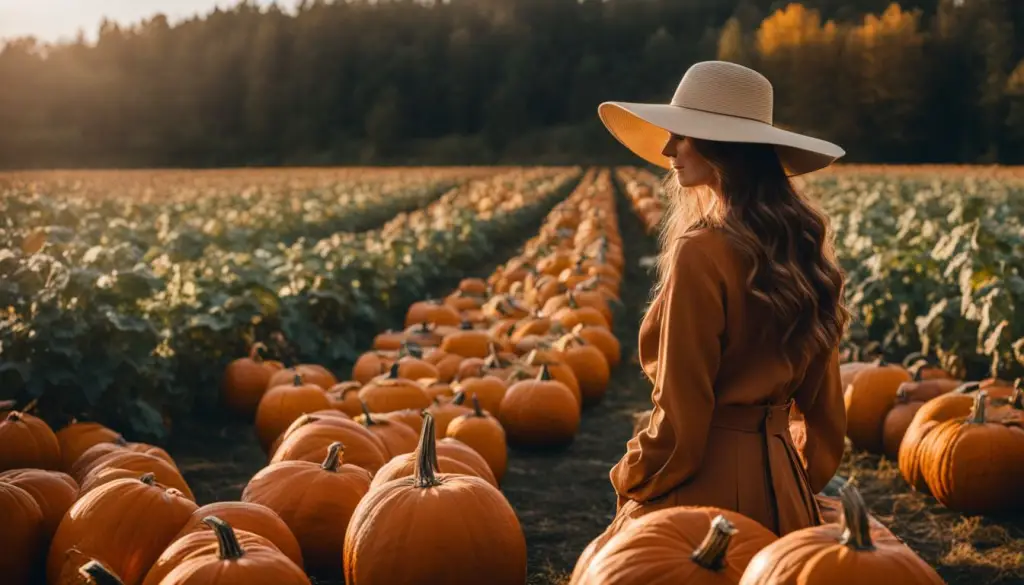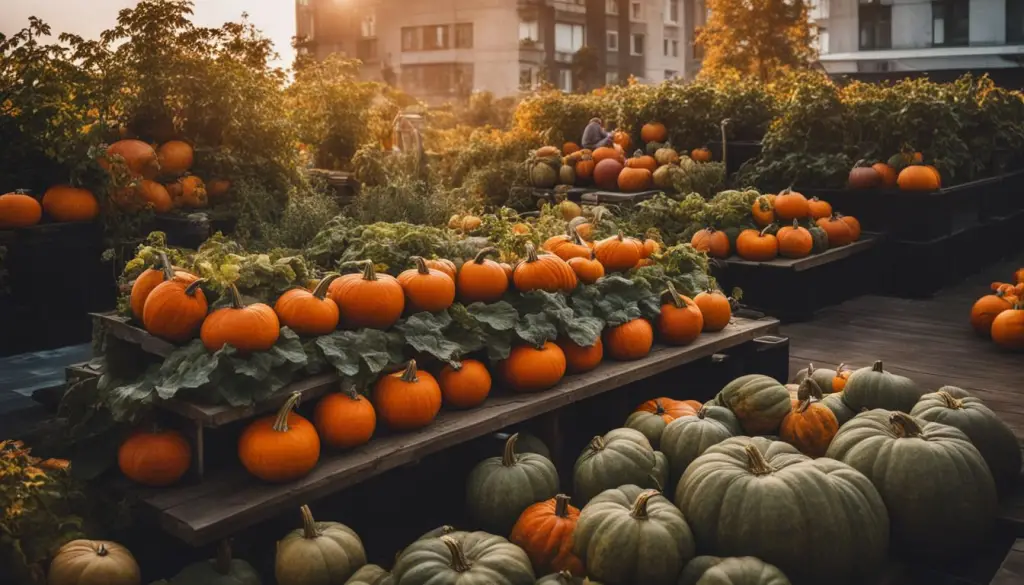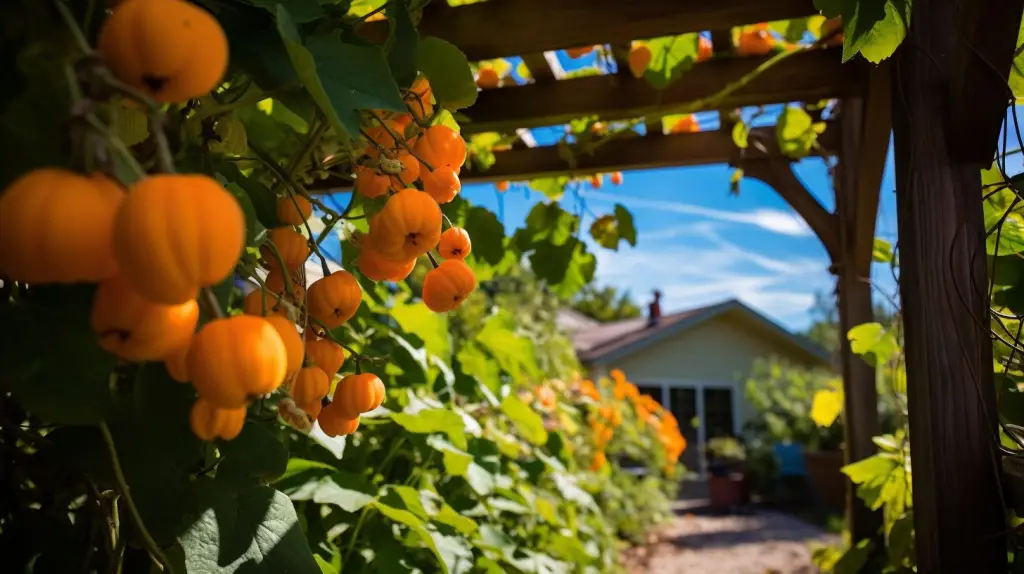Finding a space to grow pumpkins can be particularly challenging, especially when the available area is small. However, with the right techniques and pumpkin varieties, it’s entirely possible to cultivate these festive vegetables in limited spaces.
This blog will guide you on how to maximize your garden by growing pumpkins vertically using innovative methods and what you need for successful pumpkin farming in small areas. Let’s turn that little corner into a flourishing pumpkin patch!
Contents
ToggleKey Takeaways
- Growing pumpkins vertically on a trellis or in containers is a smart way to maximize space in small gardens.
- Small pumpkin types, such as Baby Boo and Munchkin, are perfect for growing in limited spaces.
- Protecting your plants from frost can help them survive and produce healthy fruits.
- Regular watering, hand pollination, and proper pest management are essential to get beautiful pumpkins in small spaces.
Understanding Small-Space Pumpkin Varieties

Mini pumpkins are compact kinds of pumpkins that are ideal for growing in your small spaces.
What are small pumpkins?
Little pumpkins are really fun and easy to grow. They weigh less than four pounds. Some may even be less than a pound. A single plant can give you many tiny pumpkins, sometimes more than twelve! These small guys need up to 100 days of growing time.
This helps them grow big and strong, even if they stay small in size. There are different kinds of pumpkins too. Some grow on long vines while others like to keep it tight in bush-like plants.
You can find these cuties in garden beds, pots, or even on hills.
To understand more about how plants grow in general, check out this article.
Popular little pumpkin varieties to grow
Choosing the right type of pumpkin for your small space is crucial. Here are some popular miniature pumpkin types you can grow:
- Baby Boo pumpkin is a pint-sized, white-colored favorite.
- Munchkin pumpkins have their own cute charm.
- Bumpkin pumpkins are great for carving.
- Baby Pam pumpkins are perfect for pies.
- Cannon Ball pumpkins are round and firm.
- Blanco pumpkins stay white even when they mature.
- Mischief pumpkins have a deep orange color, perfect for Halloween.
- We-Be-Little pumpkins are great to eat and display in fall decorations.
- Autumn Gold pumpkins mature quickly to a golden hue.
- Bushkin and Spirit give you a good harvest in less space.
Preparing Your Space for Pumpkin Planting

Before you start growing, prepare the space by ensuring it receives adequate sunlight and has a suitable temperature, as pumpkins grow best in such conditions.
The importance of sunlight and temperature
Sunlight is key for growing your pumpkins. They need a sunny spot with six hours of sun each day. Warm weather is also important. Pumpkins grow best in heat, so make sure your space has warmth.
If the temperature drops too low, it can stop the growth of your pumpkins. So, think about sunlight and temperature when you choose where to plant your pumpkins.
Preparing the soil
The first step is to dig a hole for your pumpkin. The soil should be loose and rich so that the plant roots can grow well. Next, fill the hole with this good soil and mix in some organic matter or manure additives.
This helps pumpkins grow strong and healthy. It’s best to plant your pumpkins in a sunny spot where they will get at least six hours of sunlight each day for proper growth.
Protection against frost
Pumpkins are vulnerable to frost, which can harm the plants and ruin the pumpkins. To protect your pumpkin plants from frost, there are a few methods you can use. One option is to cover them with blankets or plastic sheets before the first frost of the season.
This helps to trap heat and prevent the cold air from reaching the plants. Another method is to create a makeshift tent using wire fencing or stakes covered with a frost cloth. This creates a protective barrier around the plants and keeps them warm during chilly nights.
By taking these steps, you can ensure that your plants stay safe from frost damage and continue to grow healthy and strong.
Innovative Techniques for Growing Pumpkins in Small Spaces

Grow vertically on a trellis, use containers, create pumpkin hammocks along fences, and employ a pergola for optimal small-space pumpkin growth.
Growing vertically on a trellis
Growing your pumpkins straight up on a trellis is a smart and space-saving technique. It can save you money and make the most of your small garden or containers. All you need is a pumpkin tower made from rolled wire fencing.
The tower requires just a 2 X 2 square foot garden space or a large container, making it perfect for small spaces. Plant the pumpkin seeds around the perimeter of the tower, and watch as your vines climb up and produce beautiful miniature or medium-sized pumpkins.
It’s an innovative way to grow while maximizing your little area!
Using containers
Using containers is another great way to grow pumpkins in a small area or even if you live in a small apartment with a balcony and still enjoy the fresh fruits of your labor. By using containers, you can grow mini pumpkins on a sunny patio or balcony, making it suitable for tiny spaces.
Not only does this method save space, but it also saves money compared to buying pumpkins from the store. Different varieties of pumpkins, such as miniature or medium-sized ones like Baby Boo, Munchkin, and Bumpkin can be successfully grown straight up in containers.
Just make sure your containers are large enough to accommodate the pumpkin vines and provide adequate drainage. Additionally, remember that container-grown pumpkins require a sunny location with at least 6 hours of sunlight each day for optimal growth.
Pumpkin hammocks along fences
Hammocks are also a clever way to grow your plants, especially along fences. These hammocks allow you to maximize your growing area and save space. By hanging the plants in these hammocks, you can provide support for the vines as they grow.
This technique is great for homeowners who want to grow pumpkins but have not much room available. With pumpkin hammocks, you can enjoy a larger yield of pumpkins while still utilizing every inch of your garden or backyard!
Employing a pergola
Another innovative technique for growing miniature pumpkins is by employing a pergola. A pergola is an overhead structure with supporting beams, often used to provide shade or support climbing plants.
By training your pumpkin vines to grow up and over a pergola, you can save space in your garden while still allowing the pumpkins to spread out and grow. The sturdy beams of the pergola provide ample support for the weight of the pumpkins, ensuring they don’t fall off as they ripen.
This method works especially well if you have limited horizontal space but plenty of vertical space available.
If you’re curious about how other structures, like greenhouses, aid in plant growth, dive into this guide.
Caring for Your Pumpkin Plants

Given that pumpkins are heavy feeders, it’s crucial to water your plants regularly and deeply, ensuring that the soil is consistently moist but not waterlogged.
Watering needs
Pumpkins need regular and consistent watering to thrive. It’s important to water them deeply and make sure the soil stays moist. But be careful not to overwater, as it can cause rot or disease in the plants.
Aim for about 1 inch of water per week, whether from rainfall or irrigation. When you water, focus on the base of the plant rather than wetting the leaves, as this helps prevent disease.
Dealing with pests and diseases
Pests and diseases can damage your plants, but there are ways to deal with them. Here are some tips:
- Keep an eye out for squash bugs and remove them by hand.
- Treat powdery mildew with organic products like buttermilk.
- Prune off infected leaves to prevent the spread of fungal infections.
- Provide good airflow around the plants to discourage mold growth.
- Water at the base of the plant to avoid wetting the leaves, which can lead to disease.
Companion planting can also be a natural way to deter pests. Learn about companion plants for squash and beans to enhance your garden’s health.
Hand pollination for success
Hand pollination is an important technique for increasing the chances of growing successful pumpkins. This method involves manually transferring pollen from the male flower to the female flower.
It can be necessary when there are not enough natural pollinators around. Hand pollination helps ensure proper fertilization, which is necessary for fruit development. To hand pollinate, you can use a small brush or cotton swab to transfer pollen between flowers.
This simple step can greatly improve your pumpkin yield and overall success in growing your pumpkins.
Harvesting Your Pumpkins
Once your pumpkins have reached full maturity, it’s time to harvest them so you can enjoy the fruits of your labor. You’ll know they’re ready when the pumpkin is fully colored and the skin is hard.
To harvest, use pruning shears or a sharp knife to cut the stem about 2-3 inches above the pumpkin. Be careful not to damage the fruit during this process.
After harvesting, it’s important to handle your pumpkins with care to prevent any bruises or cuts that could lead to rotting. To store them, find a cool and dry place where they can be kept for several months.
Make sure there is good air circulation around each pumpkin by placing them on a raised surface or using wooden slats.
Remember that different varieties may have different storage requirements, so it’s always a good idea to check the specific instructions for each type of pumpkin you’ve grown. With proper harvesting and storage techniques, you’ll be able to enjoy your homegrown pumpkins long after they’ve been picked from your small garden.
Conclusion: Enjoying the Fruits of Your Labor
In conclusion, growing pumpkins in tiny spaces is not only possible but also rewarding. By utilizing innovative techniques like vertical gardening and using containers, you can save space while enjoying a bountiful harvest of miniature or medium-sized pumpkins.
With proper care and attention to sunlight, soil preparation, and pest management. you can cultivate your own pumpkin patch right in your backyard. So get ready to savor the flavors of fall by growing your very own pumpkins!
FAQs
1. Can you grow pumpkins in a little space?
Yes, you can grow pumpkins up and down in your garden or large container. Using methods like the pumpkin tower trellis, even a small 2 X 2 square foot garden space can yield miniature or medium pumpkins.
2. What are some key things needed to start growing my own pumpkin tower?
To start growing your own pumpkin tower, use good soil and plant pumpkin seeds in a sunny location for planting that is safe from high winds. You will need wire fencing, wire cutters, and zip ties to create the structure for training the pumpkin vines.
3. How do I keep my pumpkins healthy during the growth period?
Pumpkin plants need lots of sun and good soil with organic matter manure additives to stay healthy. To stop pests such as squash bugs and diseases like powdery mildew, try using organic treatment with buttermilk.
4. Are there specific varieties of pumpkins that thrive better when grown straight up?
Smaller Pumpkin kinds such as Baby Boo, Munchkin Bumpkin, Blanco and We-Be-Little often work best when using vertical methods like creating arbor arches or A-shaped trellises for vine crops.
5. What steps should be taken when it’s time to harvest the pumpkins?
When harvesting pumpkins look out for deep orange color signs on your variety including Autumn Gold or Spirit types.. Use a sharp knife to cut them off from their vines ensuring not causing any harm.
6. How can I provide extra support if needed while my Pumpkins grow on the towers?
To give more support while growing tall – you may want additional support for your fruits by making pumpkin hammocks from pantyhose which is tied up along fences or pergolas protecting both fruit and vine.























































